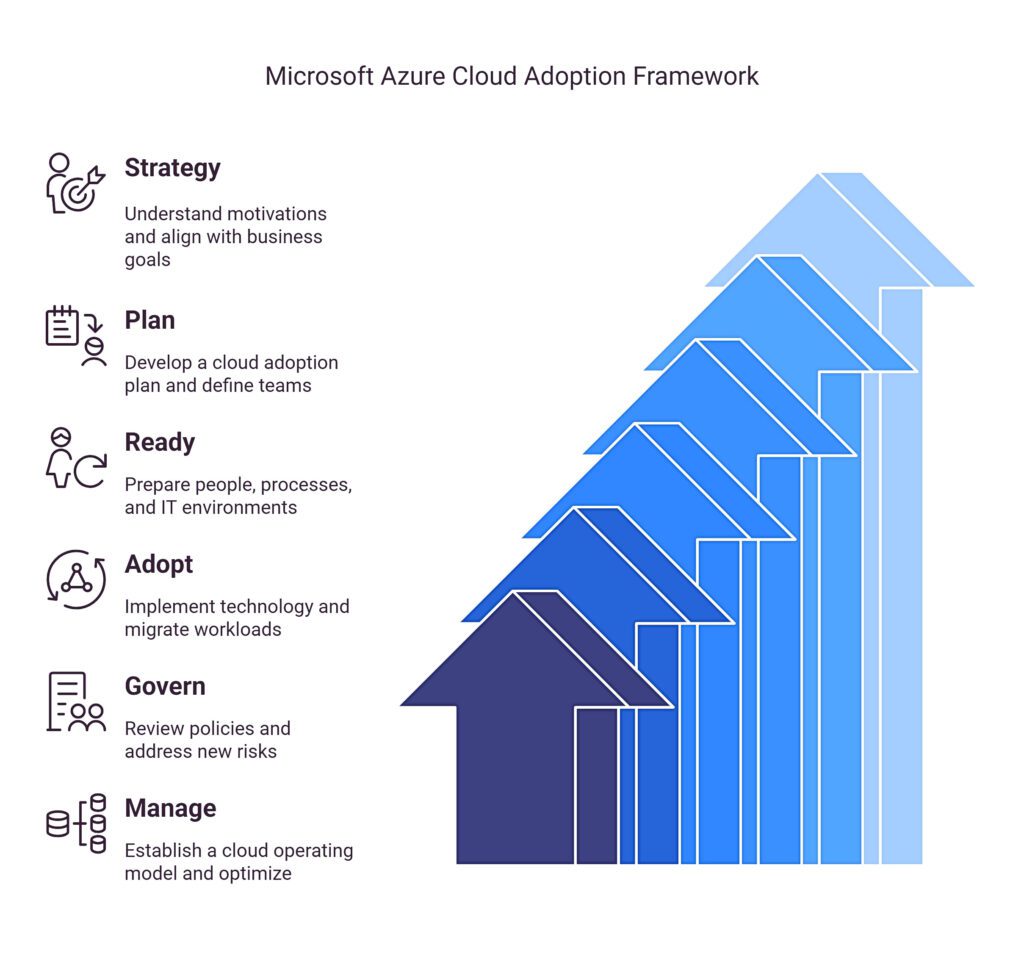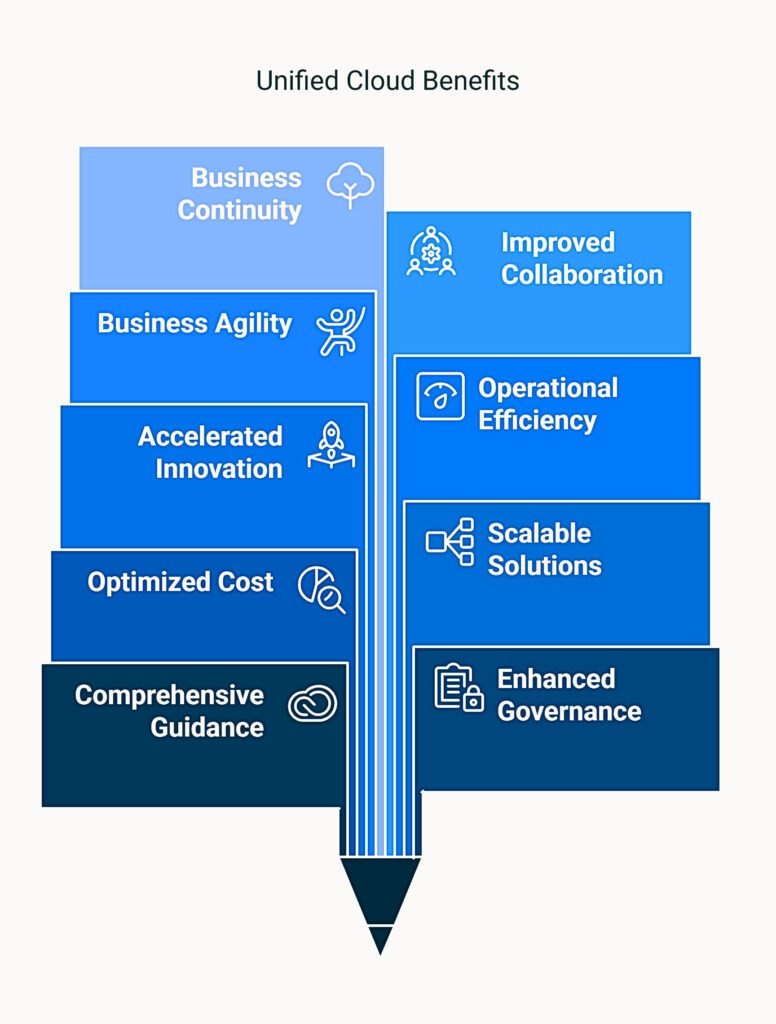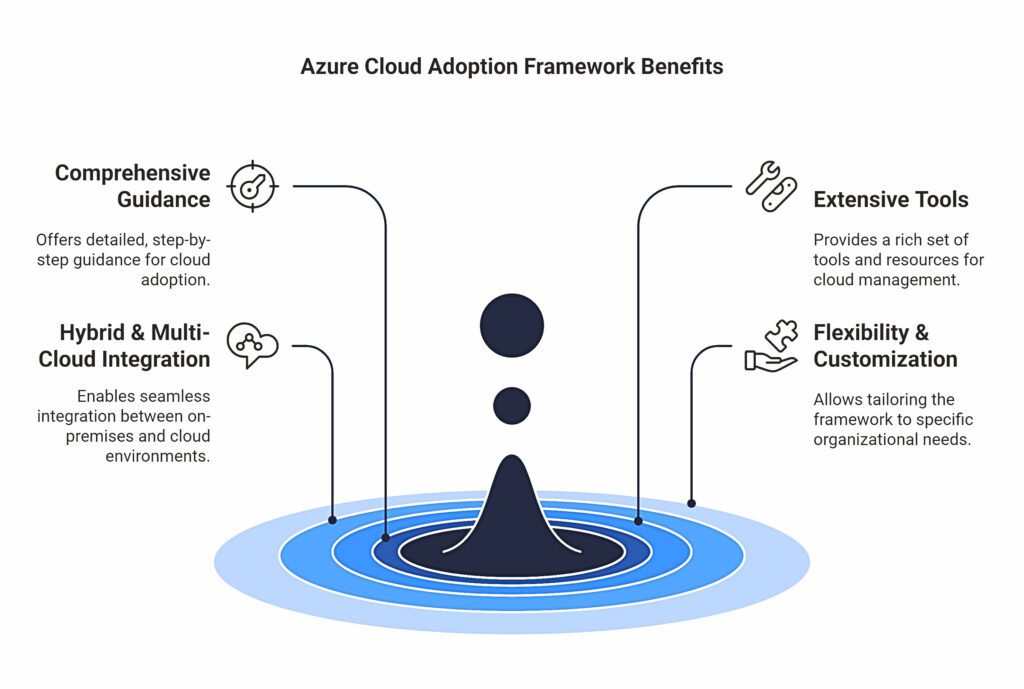- April 22, 2025
Looks like Azure cloud services has become a significant topic everywhere! Several organizations are adopting various Azure cloud strategies for betterment of their business and to stay secure by optimizing their cloud performance. The Microsoft Azure Cloud Adoption Framework provides a comprehensive guide to help organizations plan, implement, and manage their cloud adoption journey.
This framework is designed to support businesses in leveraging Azure’s capabilities to achieve their strategic objectives while ensuring a smooth transition and optimal cloud management. We came up with a comprehensive blog to understand the importance of Azure cloud adoption framework and its benefits to your organization.
Come, let’s check this!!
Understanding Microsoft Azure Cloud Adoption Framework
The Azure Cloud Adoption Framework offers proven guidance to help you develop and execute the business and technology strategies essential for cloud success. It delivers cloud best practices, documentation, and tools needed by cloud architects, IT professionals, and business decision-makers to effectively reach their short- and long-term goals.
Designed with a modular approach, the Azure Cloud Adoption Framework enables organizations to break down their cloud journey into distinct stages. It provides clear guidance for business decision-makers, cloud architects, and IT professionals, ensuring they can confidently and effectively manage their cloud adoption. This framework aligns business priorities and expected outcomes with technological changes and investments.
Each stage of the framework targets specific facets of the cloud journey, enabling organizations to address them internally. Here is an overview of each stage:

- Strategy: Understand the motivation for adopting new cloud technologies by considering business and financial justifications and aligning them with business goals and expected outcomes.
- Plan: Develop a cloud adoption plan based on an inventory of the current digital estate, prioritized workloads, and a suitable migration strategy for business impact. At this stage, define the cloud strategy team and center of excellence to ensure proper execution.
- Ready: Prepare people, business processes, and IT environments for the transition, based on the prioritized and agreed-upon cloud adoption plan. Utilize landing zones and replicable mechanisms to enable agility with appropriate governance and controls.
- Adopt: Implement the technology to either migrate existing workloads to the cloud or create new innovations. This stage focuses on delivering on business expectations and aligning with the cloud adoption plan.
- Govern: Review existing on-premises IT policies and define complementary cloud governance. Learn to iterate as the cloud estate, business priorities, and processes evolve over time, addressing new risks as they arise.
- Manage: Establish a cloud operating model focused on operational excellence. Continuously monitor, manage, and optimize cloud environments to meet business goals and expected outcomes.
Benefits of Adopting Azure Cloud Adoption Framework
The Microsoft Azure Cloud Adoption Framework provides a structured and strategic approach to cloud adoption, offering numerous benefits that span various aspects of an organization’s cloud journey. Here is an expanded look at the key benefits:

1. Comprehensive Guidance
Structured Roadmap: Azure managed cloud services Offers a step-by-step guide that covers all stages of cloud adoption, from initial strategy and planning to implementation and ongoing management, ensuring nothing is overlooked.
Best Practices: Incorporates industry best practices, ensuring organizations adopt cloud technologies in the most effective and efficient manner.
2. Enhanced Governance and Compliance
Policy Enforcement: Facilitates the creation and enforcement of governance policies that ensure data security, compliance, and regulatory adherence.
Risk Management: Helps identify and mitigate risks associated with cloud adoption, including security vulnerabilities and compliance issues.
3. Optimized Cost Management
Cost Control: Azure managed services provide tools and strategies for monitoring and managing cloud expenditures, helping organizations avoid unexpected costs and optimize resource usage.
Financial Planning: Assists in aligning cloud spending with business goals, ensuring a clear understanding of the budgetary impact and benefits.
4. Scalable and Flexible Solutions
Elastic Resources: Supports the development of scalable solutions that can easily adjust to changing business demands, ensuring optimal performance and cost efficiency.
Flexibility: Allows for the seamless integration of hybrid and multi-cloud environments, providing the flexibility to choose the best deployment model for specific workloads.
5. Accelerated Innovation
Advanced Technologies: Encourages the exploration and adoption of cutting-edge technologies such as artificial intelligence, machine learning, and Internet of Things (IoT), driving innovation.
Faster Deployment: Enables quicker deployment of new applications and services, reducing time-to-market and enhancing competitive advantage.
6. Operational Efficiency
Automated Processes: Promotes the use of automation tools to streamline and optimize operational processes, reducing manual intervention and the potential for errors.
Proactive Monitoring: Incorporates proactive monitoring and management tools that help maintain optimal performance and quickly address any issues that arise.
7. Business Agility
Adaptability: Enhances the ability to quickly adapt to market changes and customer demands, providing a competitive edge in a rapidly evolving business landscape.
Innovation Enablement: Supports a culture of innovation by providing the tools and frameworks necessary to experiment and implement innovative ideas effectively.
8. Improved Collaboration
Unified Platform: Facilitates better collaboration across teams and departments by providing a unified platform for development, deployment, and management.
Integrated Tools: Leverages integrated tools that enhance communication and collaboration, fostering a more cohesive and productive work environment.
9. Business Continuity and Disaster Recovery
Robust Backup Solutions: Ensures that data is consistently backed up and easily recoverable, reducing the risk of data loss.
Disaster Recovery: Provides robust disaster recovery options that ensure business continuity in an outage or disaster.
How Azure Cloud Adoption Framework Differ from other Cloud Platforms?

- Comprehensive & Unified Guidance: Azure managed cloud services provides a holistic, end-to-end framework that covers every aspect of the cloud adoption journey, from strategy and planning to governance, management, and innovation. They offer detailed, step-by-step guidance tailored to various stages of cloud adoption, ensuring a structured and thorough approach.
- Extensive Tools & Resources: Azure services a rich set of tools, templates, and best practices to facilitate each phase of cloud adoption. They provide resources for skill development and training, ensuring teams are well-prepared to manage Azure environments.
- Focus on Hybrid & Multi-Cloud Integration: Azure cloud services Strongly emphasizes hybrid cloud strategies, enabling seamless integration between on-premises environments and the Azure cloud. It supports multi-cloud approaches, offering flexibility and interoperability with other cloud providers.
- Flexibility & Customization: Azure provides Highly customizable, allowing organizations to tailor the framework to their specific needs, industry requirements, and existing IT environments. It supports a wide variety of use cases, from simple migrations to complex, multi-phased digital transformations.
Conclusion
Focusing on comprehensive guidance, robust governance, business alignment, and flexible, hybrid solutions, the Azure Cloud Adoption Framework differentiates itself as a versatile and powerful tool for organizations looking to optimize their cloud journey. Choose the best Azure cloud service provider to reap the maximum benefits.
Happy Learning!!
